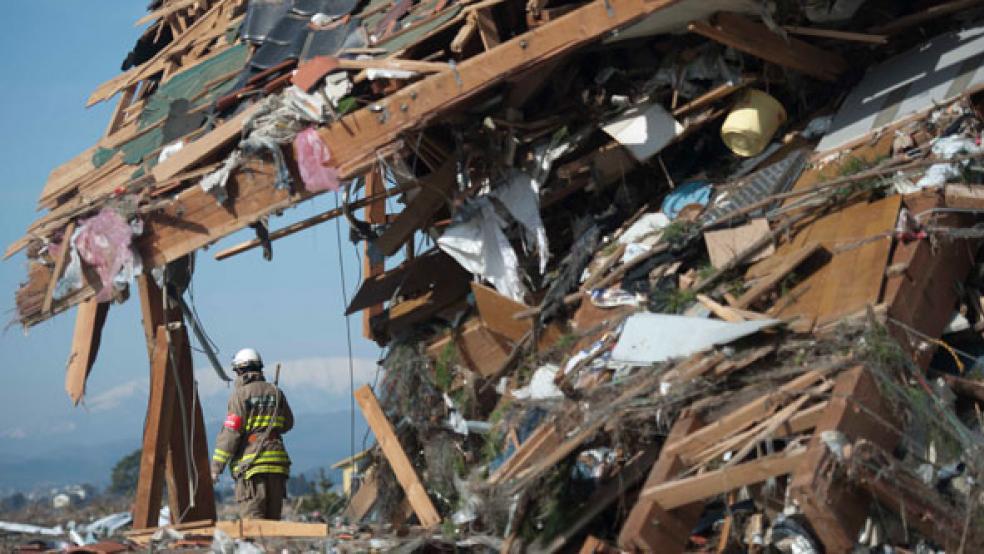Watching the tragedy in Japan unfold, one hopes for silver linings. Surely something positive can come out of all the misery. For years Japan has struggled to grow, burdened by the fastest-aging population in the developed world, an economy still tangled with regulation and increased competition from its energetic Asian neighbors. Prodded by the earthquake, could the government undertake a massive reconstruction effort that would finally lift the country out of its enduring malaise?
Sadly, no. Decades of futile deficit spending have emptied the government’s coffers and narrowed its ability to respond to disaster. While Japan will need vast new investment — to rebuild power plants and factories, roads and airports — it will not come from a government whose debt already tops 200 percent of GDP. Even now, political leaders in Japan are considering a temporary tax hike to fund reconstruction. What could more readily counter recovery efforts than rising taxes? This surely is a cautionary tale.
Embodiment of Existential Threat
Japanese investors have long muttered darkly about tsunamis. To residents of that country, the destructive waves unleashed by shifting tectonic plates are not simply potential natural disasters, but the embodiment of an existential threat. Tsunamis symbolize to the Japanese the fragility of life and the uncertain nature of the universe. They are, for instance, one reason that for decades the Japanese people had a higher savings rate than that of any other developed country. In the early 1980s, a period of rising incomes and property values, the Japanese were putting aside over 15 percent of their income. (By comparison, the U.S. savings rate topped out at about 12 percent in the early 1980s but dropped consistently to around 2-to-3 percent in the 2000s. Only with the financial crisis did the U.S. savings rate move above 5 percent.)
In recent years, that changed. In the decade ending in 2007, the savings rate in Japan plunged from over 11 percent of disposable personal income to only 2.2 percent. Today it stands at 2.4 percent. Declining incomes, an increased number of retirees and a desire to maintain consumption levels adopted during the fat years caused people to save less. The amount that most families put aside fell despite shrinking wealth brought about by sharply lower stock and home prices. The stock market peaked at the end of 1989, and is currently trading (after a sharp sell-off sparked by the earthquake) some 74 percent below that top, while home prices dropped in half during the same period. In part, the less cautious posture was also the result of beefed up government social security programs such as retirement benefits. Why not enjoy life today if the government is going to take care of you tomorrow?
Notwithstanding a declining savings rate and continued efforts by the government to stimulate spending, the Japanese economy has been inert, growing at less than 1 percent per year over the past ten years. To counter this stagnation, the government undertook in the 1990s no less than 10 separate stimulus programs, focused on infrastructure, of the sort that liberal economists like Paul Krugman are endlessly urging on the U.S. The repeated programs failed to boost growth, but drove government spending as a percentage of GDP from one of the lowest ratios among its developed world peers — 31 percent in 1991 — to 38 percent, one of the highest. Public debt in Japan soared, leading to its current level of 218 percent. IMF official Naoyuki Shinohara said last month at a conference, “If you look at Japan’s outstanding debt and fiscal deficits, I think they are not sustainable over the medium and long term.” Confirming the fragile state of Japan’s finances, Moody’s rating service recently lowered its outlook for Japan’s bonds and Standard & Poor’s downgraded its ratings.
As in most countries, addressing deficits is not easy. When elected last year, Prime Minister Naoto Kan warned, “Our public finances have become the worst of any developed country.” Though his party has promised an overhaul of soaring social services spending and tax reform, political opponents have balked and Kan’s popularity has plummeted. Pulling back on state-financed largesse is never easy.
Some economists have projected trouble ahead, especially if the government is successful in turning around Japan’s persistent deflation. While on the one hand investment by the private sector might bounce upwards with renewed inflation, the consequent rise in interest rates would further burden the government’s budget.
The experience in Japan is a heads-up to policy makers around the world. Governments need to have the flexibility to step in when disaster strikes. That ability is gravely threatened by jacking up debt levels when penniless governments are unable to provide the economy with a shot of adrenaline. Extreme indebtedness also threatens sustainable growth — one reason why many opposed a second round of stimulus spending in the U.S.
Though the Recovery Act was justified by the sudden collapse in the economy and in consumer confidence, further spending was likely to raise alarms about our country’s fiscal health and crimp the government ‘s options going forward. As it is, the United States is close to the danger zone.
Just today the Federal Reserve decided to leave interest rates at current record-low levels, arguing that economic shocks around the world call for continued stimulus. It may be that rising oil prices or a possible downturn in Japan could set back growth. On the other hand, what is left in the U.S. quiver? With both monetary and fiscal policy in open-throttle mode, what happens if the U.S. confronts come unforeseen disaster? Let us hope we do not encounter our own tsunami.
Related Links:
Japan’s High Debt Load May Slow Post-Earthquake Reconstruction (Seeking Alpha):
High-Yield Debt Market Is Laid Low by Investor Anxiety (WSJ):
Global Stock Rally May Withstand Japan Disaster (Bloomberg News):



